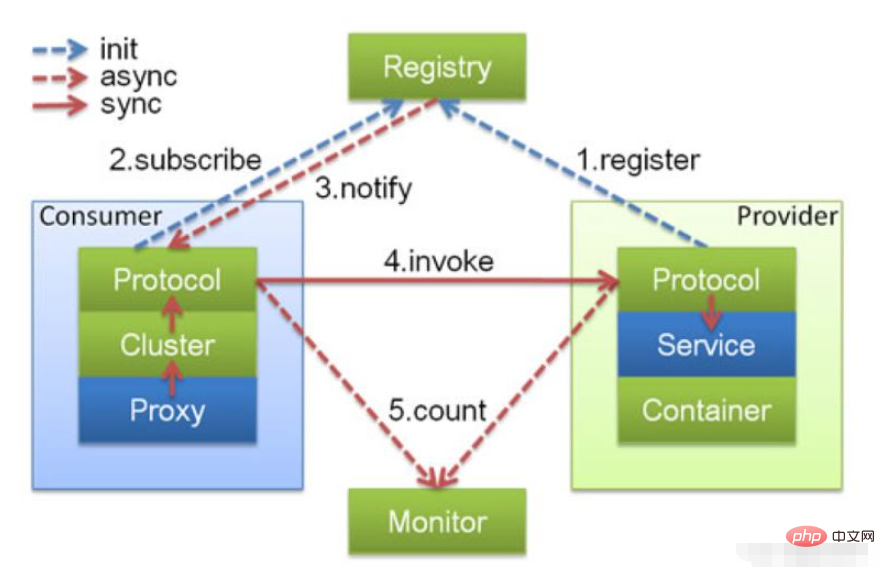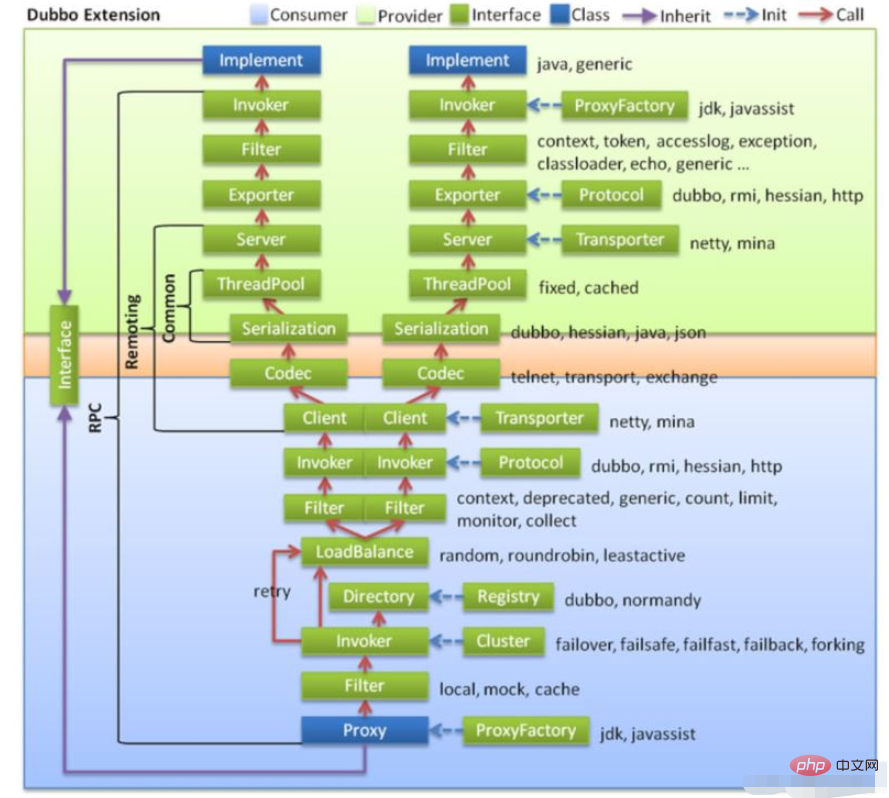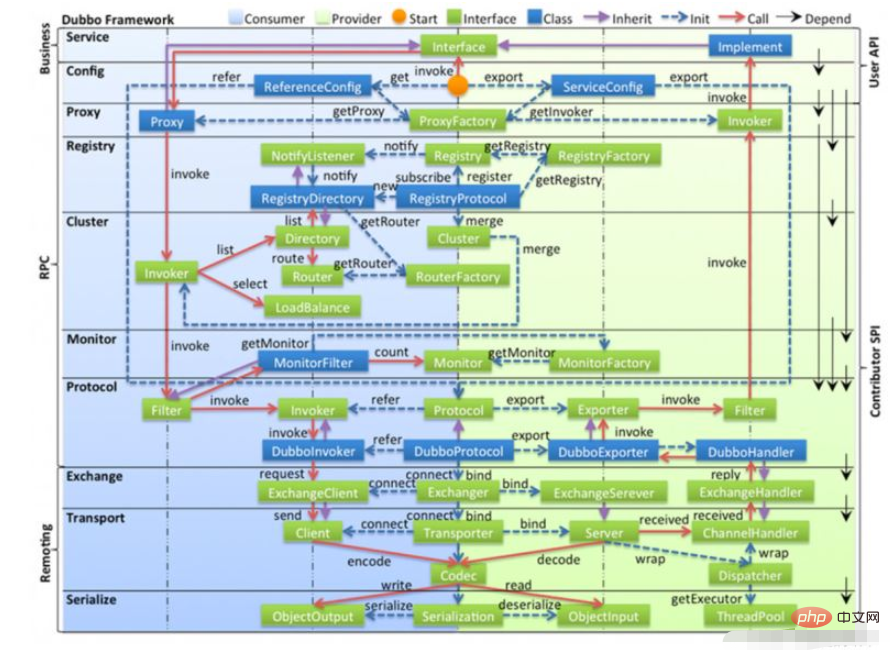What is the overall design method of java Dubbo architecture?
1. Dubbo calling relationship description

Here It is mainly composed of four parts:
● Provider: the service provider that exposes the serviceProtocol: responsible for the protocol interaction data between the provider and the consumer
Service: the real business service Information can be understood as interfaces and implementations
Container: Dubbo's operating environment
● Consumer: The service consumer that calls the remote service
Protocol: Responsible for the protocol interaction data between the provider and the consumer
Cluster: Perceives the list information on the provider side
Proxy: It can be understood as the provider's service calling proxy, which takes over the interface calling logic in the Consumer
● Register: Registration center, used for service discovery and routing configuration, etc. Work, providers and consumers will be registered here
● Monitor: used for data statistics on providers and consumers, such as call frequency, number of successes and failures, etc.
● When the consumer side starts, it senses the provider information by listening to the provider list, and When the provider changes, the consumer is promptly notified through the registration center
● The consumer initiates a request through the Proxy module;
● The consumer uses the Cluster module to select the real provider to be called;
● Consumer Use the Protocol in the Consumer to send the information to the provider;
● The provider processes consumer information through the Protocol module;
● Finally, the provider's Service handles the processing

The overall calling process is as follows:
● Consumers call methods through the Interface, unified It is handed over to the Proxy on the consumer side and the proxy object is created through ProxyFactory. The javassist technology of jdk is used here● It is handed over to the Filter module to make unified filtering requests
● Next is the most important Invoker calling logic
○ Read information from the configuration through Directory, and finally obtain all Invokers through the list method
○ Through the Cluster module, select the Invoker list according to the selected specific routing rules
○ Through the LoadBalance module, according to the load balancing policy Select a specific Invoker to handle the request
○ If an error occurs during execution, and the retry mechanism is configured in the Consumer stage, the execution will be retried
● Continue to use the Filter to encapsulate the execution function before and after, and the Invoker selects a specific Invoker Execute the protocol
● The client performs encoding and serialization, and then sends the data
● Reach the Server layer in the Provider to decode and serialize the received data
● Use Exporter to select the executor
● Let the Filter perform a provider-side filtering and reach the Invoker executor
● Call the specific implementation of the interface through the Invoker, and then return the result

Legend:
● In the figure, the light blue background on the left is the interface used by the service consumer, and the light green background on the right is the interface used by the service provider. The interface located on the central axis is used by both parties.● The figure is divided into ten layers from top to bottom. Each layer has one-way dependencies. The black arrow on the right represents the dependency relationship between layers. Each layer can be stripped off the upper layer and reused. Among them, the Service and Config layers is an API, and all other layers are SPI
● The green blocks in the picture are extension interfaces, and the blue blocks are implementation classes. The picture only shows the implementation classes used to associate each layer
● The blue blocks in the picture are The dotted line is the initialization process, that is, the assembly chain at startup. The solid red line is the method calling process, that is, the runtime call chain. The purple arrow is inheritance. The subclass can be regarded as the same node of the parent class. The text on the line is the call Methods.
The following is a layered introduction
1. Business logic layer
● Service business layer: including business code such as interfaces and implementation classes
2. RPC layer: remote procedure call layer
● config configuration layer, which provides configuration to the outside world. ServiceConfig and ReferenceConfig are the core, which can directly initialize the configuration class or parse the configuration file
● Proxy service agent layer, whether it is a producer or a consumer, the framework will generate a proxy class. The whole process is transparent to the upper layer, and the business layer Remote calls are insensitive
● Register registration center layer, which encapsulates the registration and discovery of service addresses, with the service URL as the center
● Cluster routing layer (cluster fault-tolerant layer), provides routing and load for multiple providers Balanced, and it bridges the registration center with Invoker as the center
● Monitor monitoring layer, RPC call-related information, such as the number of calls, failure situations, call time and other statistical information will be completed in this layer
● Protocol remote The call layer, which encapsulates RPC calls, whether it is service exposure or service reference, is responsible for the entire life cycle of Invoker as the main function entrance in Protocol. All models in Dubbo move closer to Invoker
3. Rmoting layer: Remote data transmission layer
● Exchange information exchange layer, encapsulates the request and response mode, converts the request from synchronous to asynchronous
● Transport network transport layer, unifies the network transmission interface, such as Netty and mina unified into one network Transmission interface
● Serialize data serialization layer, responsible for managing the serialization and deserialization of data transmission in the entire framework
The above is the detailed content of What is the overall design method of java Dubbo architecture?. For more information, please follow other related articles on the PHP Chinese website!

Hot AI Tools

Undresser.AI Undress
AI-powered app for creating realistic nude photos

AI Clothes Remover
Online AI tool for removing clothes from photos.

Undress AI Tool
Undress images for free

Clothoff.io
AI clothes remover

Video Face Swap
Swap faces in any video effortlessly with our completely free AI face swap tool!

Hot Article

Hot Tools

Notepad++7.3.1
Easy-to-use and free code editor

SublimeText3 Chinese version
Chinese version, very easy to use

Zend Studio 13.0.1
Powerful PHP integrated development environment

Dreamweaver CS6
Visual web development tools

SublimeText3 Mac version
God-level code editing software (SublimeText3)

Hot Topics
 1387
1387
 52
52
 Perfect Number in Java
Aug 30, 2024 pm 04:28 PM
Perfect Number in Java
Aug 30, 2024 pm 04:28 PM
Guide to Perfect Number in Java. Here we discuss the Definition, How to check Perfect number in Java?, examples with code implementation.
 Weka in Java
Aug 30, 2024 pm 04:28 PM
Weka in Java
Aug 30, 2024 pm 04:28 PM
Guide to Weka in Java. Here we discuss the Introduction, how to use weka java, the type of platform, and advantages with examples.
 Smith Number in Java
Aug 30, 2024 pm 04:28 PM
Smith Number in Java
Aug 30, 2024 pm 04:28 PM
Guide to Smith Number in Java. Here we discuss the Definition, How to check smith number in Java? example with code implementation.
 Java Spring Interview Questions
Aug 30, 2024 pm 04:29 PM
Java Spring Interview Questions
Aug 30, 2024 pm 04:29 PM
In this article, we have kept the most asked Java Spring Interview Questions with their detailed answers. So that you can crack the interview.
 Break or return from Java 8 stream forEach?
Feb 07, 2025 pm 12:09 PM
Break or return from Java 8 stream forEach?
Feb 07, 2025 pm 12:09 PM
Java 8 introduces the Stream API, providing a powerful and expressive way to process data collections. However, a common question when using Stream is: How to break or return from a forEach operation? Traditional loops allow for early interruption or return, but Stream's forEach method does not directly support this method. This article will explain the reasons and explore alternative methods for implementing premature termination in Stream processing systems. Further reading: Java Stream API improvements Understand Stream forEach The forEach method is a terminal operation that performs one operation on each element in the Stream. Its design intention is
 TimeStamp to Date in Java
Aug 30, 2024 pm 04:28 PM
TimeStamp to Date in Java
Aug 30, 2024 pm 04:28 PM
Guide to TimeStamp to Date in Java. Here we also discuss the introduction and how to convert timestamp to date in java along with examples.
 Java Program to Find the Volume of Capsule
Feb 07, 2025 am 11:37 AM
Java Program to Find the Volume of Capsule
Feb 07, 2025 am 11:37 AM
Capsules are three-dimensional geometric figures, composed of a cylinder and a hemisphere at both ends. The volume of the capsule can be calculated by adding the volume of the cylinder and the volume of the hemisphere at both ends. This tutorial will discuss how to calculate the volume of a given capsule in Java using different methods. Capsule volume formula The formula for capsule volume is as follows: Capsule volume = Cylindrical volume Volume Two hemisphere volume in, r: The radius of the hemisphere. h: The height of the cylinder (excluding the hemisphere). Example 1 enter Radius = 5 units Height = 10 units Output Volume = 1570.8 cubic units explain Calculate volume using formula: Volume = π × r2 × h (4
 Create the Future: Java Programming for Absolute Beginners
Oct 13, 2024 pm 01:32 PM
Create the Future: Java Programming for Absolute Beginners
Oct 13, 2024 pm 01:32 PM
Java is a popular programming language that can be learned by both beginners and experienced developers. This tutorial starts with basic concepts and progresses through advanced topics. After installing the Java Development Kit, you can practice programming by creating a simple "Hello, World!" program. After you understand the code, use the command prompt to compile and run the program, and "Hello, World!" will be output on the console. Learning Java starts your programming journey, and as your mastery deepens, you can create more complex applications.




